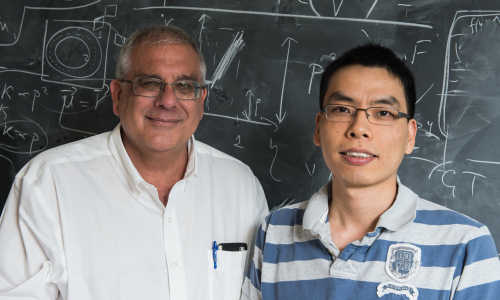Human chromosomes are much bigger and more complex than proteins, but like proteins, they appear to fold and unfold in an orderly process as they carry out their functions in cells.
Rice University biophysicist Peter Wolynes and postdoctoral fellow Bin Zhang have embarked upon a long project to define that order. They hope to develop a theory that predicts the folding mechanisms and resulting structures of chromosomes in the same general way Wolynes helped revolutionize the view of protein folding through the concept of energy landscapes.
The first fruit of their quest is a new paper in the Proceedings of the National Academy of Sciences that details a coarse-grained method to “skirt some of the difficulties” that a nucleotide-level analysis of chromosomes would entail.
Essentially, the researchers are drawing upon frequently observed crosslinking contacts among domains – distinct sequences that form along folding strands of DNA – to apply statistical tools. With these tools, they can build computational models and infer the presence of energy landscapes that predict the dynamics of chromosomes.
How macromolecules of DNA fold into chromosomes is thought to have a crucial role in biological processes like gene regulation, DNA replication and cell differentiation. The researchers argue that unraveling the dynamics of how they fold and their structural details would add greatly to the understanding of cell biology.
“It’s inevitable that there’s a state of the chromosome that involves having structure,” Wolynes said. “Since the main theme of our work is gene regulation, it’s something we would naturally be interested in pursuing.”
But it’s no small task. First, though a chromosome is made of a single strand of DNA, that strand is huge, with millions of subunits. That’s much longer than the average protein and probably a lot slower to organize, the researchers said.
Second, a large “team of molecular players” is involved in helping chromosomes get organized, and only a few of these relevant proteins are known.
Third, chromosome organization appears to vary from one cell to the next and may depend on the cell’s type and the phase in its lifecycle.
All those factors led Wolynes and Zhang to conclude that treating chromosomes exactly as they do proteins — that is, figuring out how and when the individual units along the DNA strand attract and repel each other — would be impractical.
“But the three-dimensional organization of chromosomes is of critical importance and is worthy of study by Rice’s Center for Theoretical Biological Physics,” Wolynes said. He holds out hope that the theory developed in this study will lead to a more detailed view of chromosome conformations and will result in a better understanding of the relationships of the structure, dynamics and function of the genome.
He said there is already evidence for the idea that actual gene regulatory processes are influenced by the chromosomes’ structures. He noted work by Rice colleague Erez Lieberman Aiden to develop high-resolution, three-dimensional maps of folded genomes will be an important step toward specifying their structures.
One result of the new study was the observation that, at least during the interphase state the Rice team primarily studied, chromosome domains take on the characteristics of liquid crystals. In such a state, the domains remain fluid but become ordered, allowing for locally funneled landscapes that lead to the “ideal” chromosome structures that resemble the speculative versions seen in textbooks.
Wolynes and Rice colleague José Onuchic, a biophysicist, began developing their protein-folding theory nearly three decades ago. In short, it reveals that proteins, which start as linear chains of amino acids, are programmed by genes to quickly fold into their three-dimensional native states. In doing so, they obey the principle of minimal frustration, in which interactions between individual acids guide the protein to its final, stable form.
Wolynes used the principle to conceptualize folding as a funnel. The top of the funnel represents all of the possible ways a protein can fold. As individual stages of the protein come together, the number of possibilities decreases. The funnel narrows and eventually guides the protein to its functional native state.
He hopes the route to understanding chromosome folding will take much less time than the decades it took for his team’s protein-folding work to pay off.
“We’re not the first in this area,” he said. “A lot of people have said the structure of the chromosome is an important problem. I see it as being as big a field as protein folding was – and when you look at it from that point of view, you realize the state of our ignorance is profound. We’re like where protein folding was, on the experimental side, in 1955.
“The question for this work is whether we can leapfrog over the dark ages of protein folding that led to our energy-landscape theory. I think we can.”
Story Source:
The above story is based on materials provided by Rice University.




